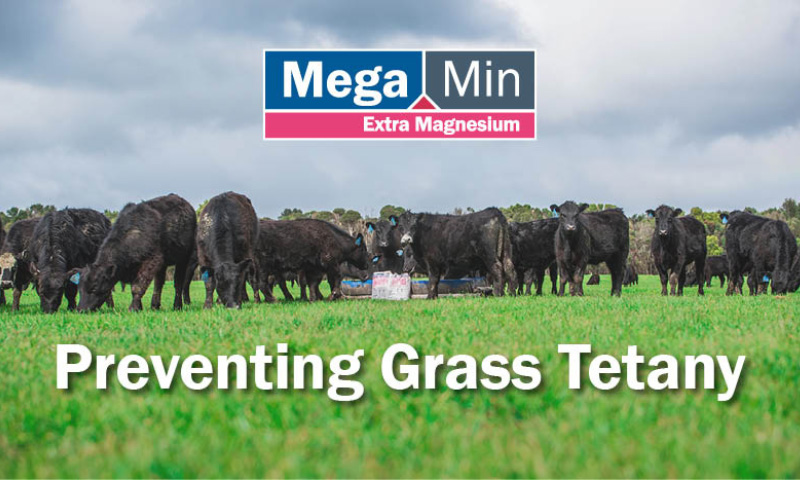Imagine the devastation if you were to head out to the paddock one morning to check on your stock only to discover that you have lost over half of your herd over night! This horrible scenario can unfortunately be quite common in situations where stock are grazing lush, green improved pastures or winter cereals. Deaths from grass tetany could pose quite a significant risk this season especially for cattle under stress from lactation, mustering or first oestrous following rain and the onset of cold conditions immediately after warm weather.
Grass tetany is correctly known as Hypomagnesaemia but you may know of it being called something else like magnesium tetany, oat tetany, lactation tetany, grass staggers, magnesium deficiency and pasture flush staggers. Grass tetany is usually confined to medium and high-rainfall regions most often where improved pastures have been established. It is regarded as an economically significant metabolic disease because, when it strikes, mortality rates can be extremely high and it can be the biggest cause of deaths in any given herd in any given year.
Grass tetany is a nervous disorder and occurs when the magnesium (Mg) concentration in the cerebrospinal fluid (CSF – fluid surrounding the brain & spinal cord) falls below a critical level and this is preceded by a decrease in blood magnesium.
Often the first sign that grass tetany is an issue is when stock are found dead in the paddock. Symptoms to look for are: hyperexcitability, restlessness, staggers, aggressiveness and muscle spasms that can lead to convulsions, respiratory distress, collapse and death. Quite often animals are found with froth around the mouth and nose and the ground is rubbed where the legs have moved violently before death.
The cause is complex, involving animal, nutritional, climatic and management factors. The incidence of grass tetany varies between seasons and locations, with the majority of clinically affected cows dying.
Grass tetany risk factors include:
- Stock grazing immature, green pasture and lush green cereal crops, often with a history of nitrogen and potassium application,
- Low magnesium diets or interference of magnesium absorption by excess potassium,
- Stress such as wind and cold exposure, lactation, transport, mustering etc.
- High risk animals are often older, fat and losing condition. Bos taurus cattle (Angus etc.) are more susceptible than Bos indicus cattle (Brahman etc.)
- Grass tetany usually occurs in Australia in late autumn and winter. During these months many cows are in mid lactation and losing condition. Pasture is often short, grass dominant and has a chemical composition unfavourable for magnesium and calcium absorption. These months are usually associated with climatic stresses such as severe chill, driving rain and strong winds.
According to (Elliott, 2009), grass tetany prone pastures have the following features:
Low:
- Magnesium (Mg) concentrations < 2 g/Kg of dry matter.
- Calcium (Ca) concentrations <3 g/Kg of dry matter.
- Sodium (Na) concentrations <1.5 g/Kg of dry matter.
High:
- Potassium (K) concentrations >20 g/Kg of dry matter.
- Nitrogen (N) concentrations >50 g/Kg of dry matter.
Animals showing clinical signs require treatment immediately by a Veterinarian but prevention is preferable to treatment as grass tetany often occurs without warning. Recommended strategies include:
- Increasing the magnesium intake for stock with a daily supplement. AgSolutions have specially formulated MegaMin Extra Magnesium and MegaMin Extra Magnesium Sweet for stock grazing lush pastures, rye grass, oats and winter cereals.
- Provide access to roughage during high risk periods as mature fodder has a higher magnesium level in the stem and will aid in slowing down the passage rate of digesta, helping to minimise scouring.
- If possible, avoid grazing high risk animals (older, pregnant or lactating animals) on high risk pastures.
- Due to older cows being at higher risk try to lower the herd age structure.
- Avoid subjecting animals to unnecessary stress (mustering, yarding, transporting) during risk periods or in the last six weeks of pregnancy. Avoid sudden changes to feed and feed quality.
- Spring calving cows will be less susceptible than autumn/winter calving cows.
Providing adequate levels of magnesium in the diet cannot be stressed enough to help prevent grass tetany. Cattle require a constant supply of magnesium in their diets and to explain this think of the fuel gauge in your car and imagine this indicating magnesium level. Image if livestock are going around all year with their magnesium level on the gage only being ¼ full. They can still function and move around but as soon as they require more magnesium to fuel production (for example in lactation) all of a sudden, the magnesium gage falls below empty and you have an animal in a dire situation. It is highly recommended to trickle feed minerals into your stock on a year-round basis via the use of a low dose supplement like MegaMin Extra Magnesium. This will help keep their mineral “tank” full and allow them to increase production as required.
For more information or to locate an AgSolutions stockist please contact 1800 81 57 57.
By Shannon Godwin (BAppSc GDTL)
